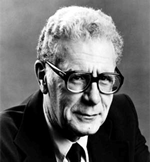Contents
What is Now-to-New?
Who is Now-to-New for?
How does Now-to-New work in practice?
What are the origins of Now-to-New?
What are the benefits of adopting the Now-to-New way of thinking, doing and being?
What is Now-to-New?
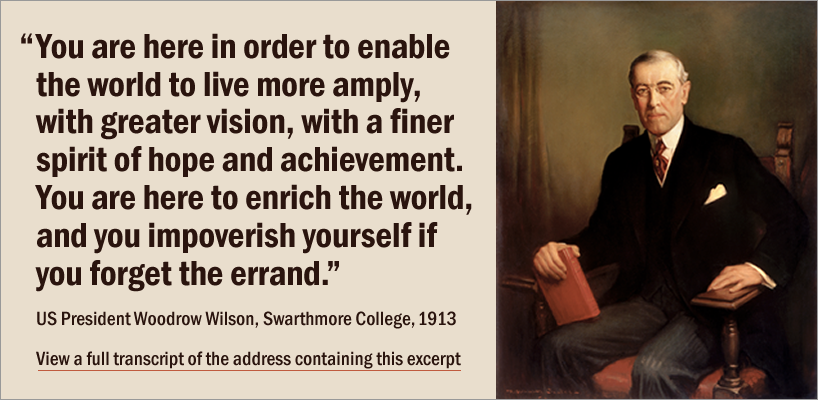
Now-to-New is a way of thinking, doing and being for those who consider Woodrow Wilson’s words and say “Yes, but how?”
The Now-to-New practitioner transcends the mundane, imagines what could be and brings it into being with the aim of enriching the world, or a particular piece of it, with value, meaning and joy.
Now-to-New is a blanket term covering seven kinds of work: creating, changing, transforming problems, surmounting, responding, developing and realising.
Creating is so named because the term is wider in its embrace than innovating.
For example, I created this webpage, but no one would describe it as an innovation. The same goes for books, songs, plays, movies, presentations, workshops, meals, and many other forms of value generator.
The seven kinds of work are neither mutually exclusive nor collectively exhaustive.
| Kind of work | Now | Example | New |
|---|---|---|---|
| Creating | There is a need, desire or opportunity to create something that will generate abundant value | We need to produce a new product concept—consumer inspired and tested—overnight | The new creation exists and is generating the desired value |
| Changing | A different state of affairs is desired | We need change the way we provide the travelling public with rail tickets | The desired state of affairs has been achieved |
| Transforming problems | Value generation capability has been impaired; anti-value is being generated. | There has been a breakdown in relations between our sales and marketing people, and remedial action is needed | Value generation capability has been restored and increased; anti-value generation has been eliminated. |
| Surmounting | There is a need, desire or opportunity to surmount a tough challenge or accomplish an almost impossible feat | We need to respond to the very real threat of new dog-to-human viral diseases entering England from mainland Europe | The challenge has been surmounted or the feat has been accomplished |
| Responding | A request has been received. | The CEO of a Dublin-based brewer has received a directive from the parent company’s chairman, instructing the brewer’s management team to establish a direct connection with its customers, beyond focus groups. How can this connection be made? | The request has been fulfilled. |
| Developing | Value generation capability is not at the required level | We need a quick and effective way of teaching our people to organise and facilitate Open Space meetings | Value generation capability is at the required level |
| Realising | Value generation potential is not being fully realised | We need to find a good use for the contaminated water that accompanies oil as it emerges from the subsurface | Value generation capability is being fully realised |
Now-to-New work is holonic, holistic and iterative.
Holonic
A holon is something that is simultaneously a whole in and of itself, as well as a part of a larger whole.
Wikipedia — Holon (philosophy)
A Now-to-New shift is often formed of lesser shifts and part of a greater one.
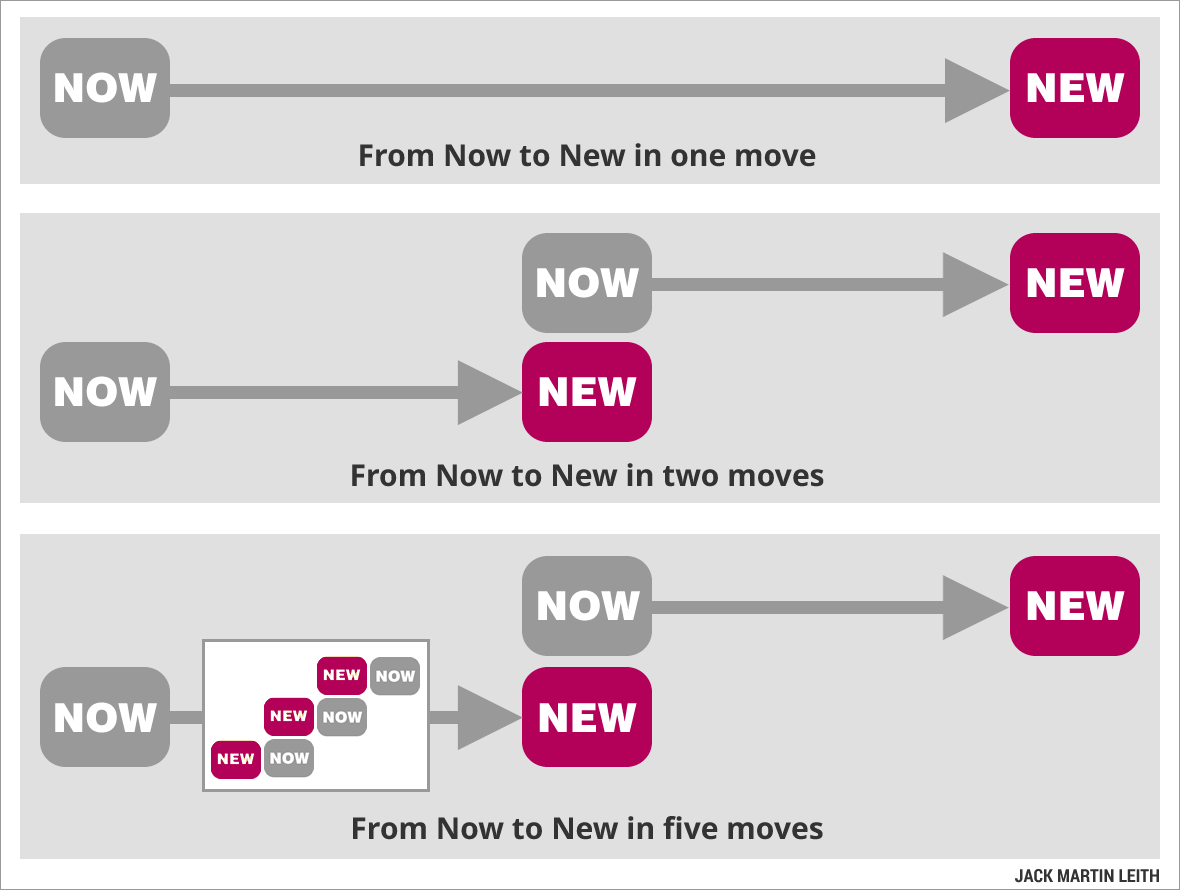
The ‘to’ in Now-to-New does not imply a time interval. Rather, it denotes a something or other that turns the current state of affairs (Now) into the desired state of affairs (New) as quickly, effortlessly and unobtrusively as possible, with fewest subordinate moves, without collateral damage and with no unintended consequences.
The something or other may be an intervention, strategy, plan, solution, mission, project, programme of work, speech act (the right thing said to the right person in the right way at the right moment) or something else altogether.
Holistic
Practitioners know that the whole cannot be understood by studying the constituent parts. They also strive to take everything into account, including that which lies beyond the material realm.
View the article: What does holistic mean?
Iterative
Practitioners make plans, but they don’t necessarily stick to them. Instead, they are constantly making adjustments in response to emerging events. The plan is simply what enables them to get to the next plan.
Who is Now-to-New for?
Now-to-New is for:
![]() People who are inspired by Woodrow Wilson’s “you are here to enrich the world” dictum and want to put it into practice.
People who are inspired by Woodrow Wilson’s “you are here to enrich the world” dictum and want to put it into practice.
![]() People involved in innovation, change and problem solving projects in the workplace.
People involved in innovation, change and problem solving projects in the workplace.
![]() People wishing to embark on a create-the-new project in their personal lives, such as establishing a YouTube channel, launching a campaign to reopen a local train station, starting a business or nonprofit organisation, or setting up a community radio station.
People wishing to embark on a create-the-new project in their personal lives, such as establishing a YouTube channel, launching a campaign to reopen a local train station, starting a business or nonprofit organisation, or setting up a community radio station.
![]() People seeking practical ways of putting Iain McGilchrist’s brain hemisphere theory into action.
People seeking practical ways of putting Iain McGilchrist’s brain hemisphere theory into action.

![]() People who want to employ mind, body and spirit when creating the new.
People who want to employ mind, body and spirit when creating the new.
![]() People who enjoy Otto Scharmer’s writings about Theory U.
People who enjoy Otto Scharmer’s writings about Theory U.
How does Now-to-New work in practice?
Now-to-New practitioners are focused on the end result — the outcome and subsequent value to be generated — rather than the means by which these ends are to be accomplished.
NOW stands for current reality, the situation in which you find yourself at this present moment.
TO represents the means by which the desired result will be accomplished. Now-to-New is not a prescribed method, although some pages of this website, existing and in the pipeline, describe tools that can assist practitioners in their Now-to-New work.
NEW signifies the desired result, which is twofold:
1. The new reality you wish to bring into existence.
2. The downstream value it is now possible to generate by virtue of this new reality.
Practitioners embrace the conventional and the unorthodox.
The mainstream and the edge.
The rational and the intuitive.
The material and the nonmaterial.
The temporal and the eternal.
The irrefutable and the contestable.
Practitioners’ way of working is method agnostic.
Now-to-New is not a prescribed practice. The practitioner uses whatever method is best suited to the work that lies ahead.
Read about some open source and proprietary Now-to-New methods
Practitioners see themselves as instruments for creating the new.
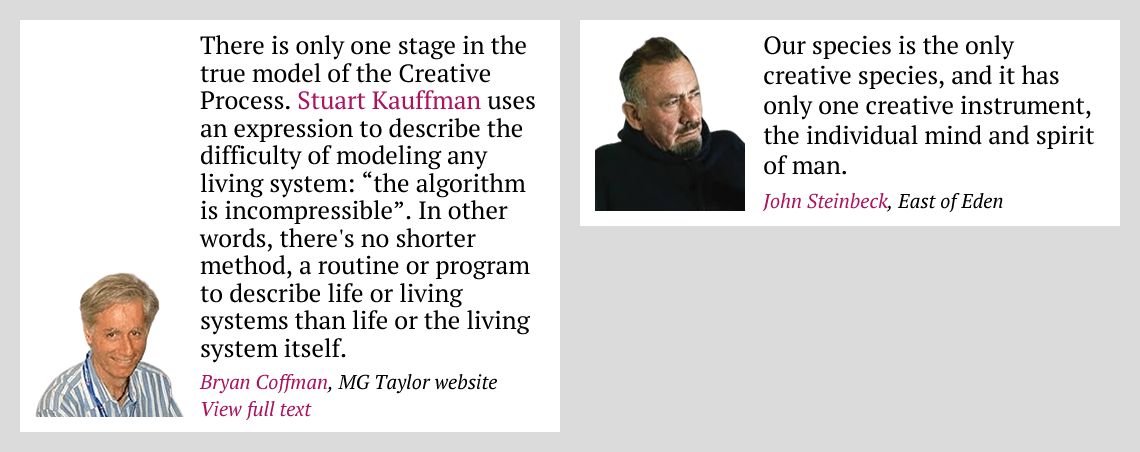 Human beings are built for converting Now into New using mind, spirit, and a third aspect that John Steinbeck doesn’t mention here: body.
Human beings are built for converting Now into New using mind, spirit, and a third aspect that John Steinbeck doesn’t mention here: body.
I’ve spent many decades working towards the embodied mind-body-spirit model pictured below.
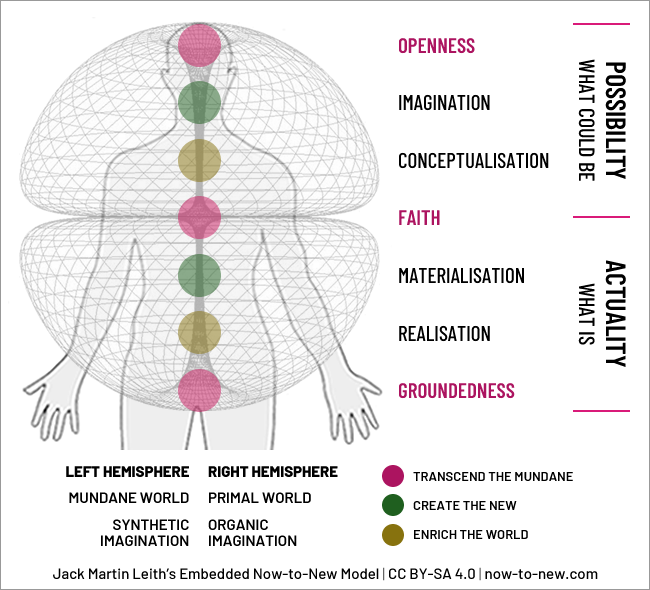
Dual torus image sourced from Michael C Grasso and decoloured
Each of the seven constituents is associated with a specific location in the body.Together, Openness, Faith (the secular kind) and Groundedness represent a state of being in which the creative faculties of Imagination, Conceptualisation, Materialisation and Realisation (of potential) are fully activated and ready to be deployed.
Read more about the embodied Now-to-New model
Practitioners use their left and right brain hemispheres as circumstances demand, deploying organic as well as synthetic imagination.
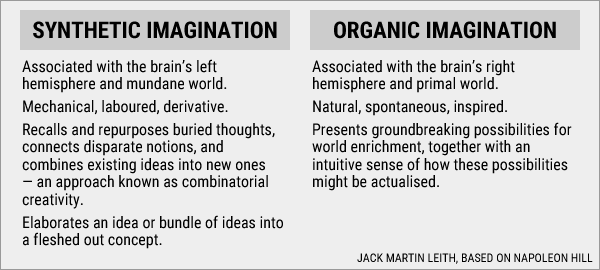
Read more about synthetic and organic imagination
Read about Iain McGilchrist, best known for his work on how the brain’s hemispheres differ in the way they attend to the world, and how each hemisphere contributes in its own way to perception, thought and behaviour. This is not a reworking of the debunked left brain / right brain theory developed by Roger Sperry and others in the 1960s.
Practitioners seek to bring forth a desired present, not a desired future.
People want what they want now, not in some hypothetical future that may never arrive.
Each moment is a new Now, a new value generation opportunity.
By using the term ‘desired present’, we open up the possibility of immediate and effortless change, even when circumstances seem to render this impossible, and we galvanise people into action.
Practitioners recognise that problem solving and change work is really about creating the new.
The work is directed towards bringing into being a new reality in which the desired value is being generated or anti-value generation is now a thing of the past.
Practitioners transform problematic situations into generative opportunities.
Problem-solving is taking actions to have something go away: the problem. While problem-solving has its place, as a persistent approach, it limits accomplishment. The elimination of a problem does not mean that the desired result can be created. As distinguished, solving a problem does not by design lead to a creation. Creating is taking action to bring into being that which does not yet exist: the desired outcome.
Source: Robert Fritz, author of The Path of Least Resistance, in Corporate Tides: The Inescapable Laws of Organizational Structure.
Problem transformation is about creating a new reality in which the problem does not exist and cannot reassert itself.“The best thing that can be done to a problem is to solve it.” False. The best thing that can be done to a problem is to dissolve it, to redesign the entity that has it or its environment so as to eliminate the problem. Such a design incorporates common sense and research, and increases our learning more than trial-and-error or scientific research alone can.
Source: A Lifetime of Systems Thinking, by Russell Ackoff, in Systems Thinker, June/July 1999.
This approach reflects the thinking of two unconnected people: conflict transformation pioneer Jean Paul Lederach and James Wilk, principal developer of minimalist intervention (pdf).
Practitioners make a clear distinction between developing and realising, which are easily confused and often conflated.
Developing means expanding value generation capability.
Realising means actualising value generation potential.
Capability is the how — skilled people, equipment, money etc.
Potential is the what — the possible future yield.

Image: Robert C. Jones
A bus operator might expand value generation capability by buying more buses, or by replacing single deckers with double deckers. Getting more people to use existing bus services would be potential realisation.Practitioners understand the imagination–realisation correlation.
What follows is unavoidably abstract. I hope I have made it sufficiently concrete. Please send me a note if you need clarification.
At the beginning of a Now-to-New project, the practitioner (entrepreneur, project team member, community activist etc.) deploys organic imagination in order to imagine a compelling value generation possibility — an opportunity for value to be experienced by certain people in a certain context.
The possibility is imagined in the present tense, as though the practitioner is inhabiting an alternate reality in which people are already deriving value. meaning and joy from some kind of value generator (see below) in a specific way.
This scenario is the vision of realised potential.
If the scenario includes the generator of this value — such as a product, service, event, establishment, educational programme, or artistic work — its form may be distinct or it may be sketchy.
The next task is to elaborate the raw idea, no matter how nebulous, into a fully-formed concept. The Idea-to-Concept Method is a way of writing and speaking it into existence. I am writing this article into existence at this very moment.
Downstream work is directed towards giving the value generator tangible form, introducing it to the world at large and realising its value generation potential. What was imagined has been actualised.
So imagination and realisation are inextricably linked. The complete cycle of work begins with the end in mind and ends with the beginning in mind.
This linkage means that in an ideal world the source, the person who did the initial imagining, remains connected to the value generator throughout its entire lifecycle, in a role something like a godparent or guardian angel. If this is not an option, then the source passes on the torch in a conscious manner.
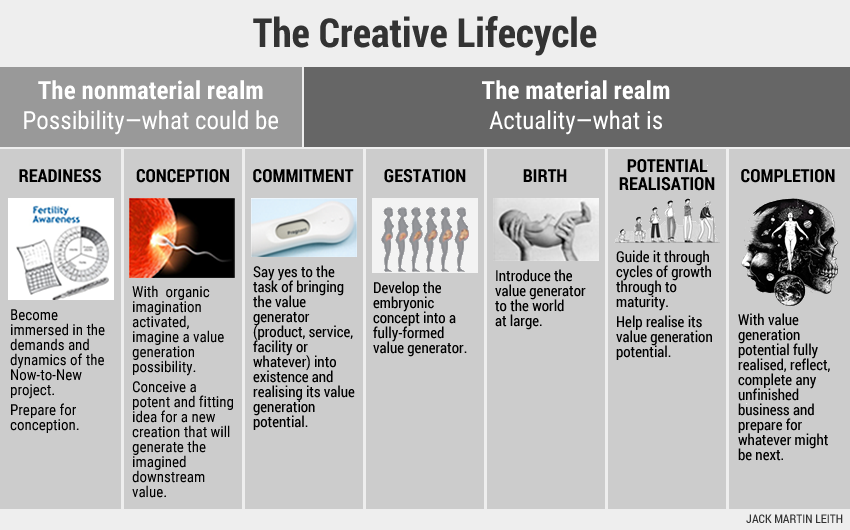
Visit the Work with Source website, featuring the discoveries of Peter Koenig, Tom Nixon, Nadjeschda Taranczewski and Charles Davies
Practitioners know that fruitful Now-to-New projects require a judicious blend of solo, collaborative and enabling work.
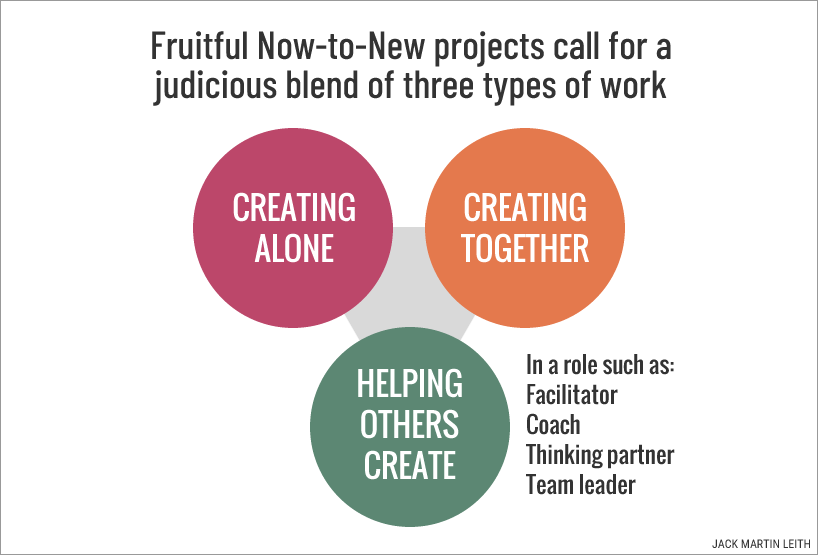
Read about the three Now-to-New action modes
What are the origins of Now-to-New?
It is the fruit of my lifelong enquiry into how the new comes into being and how this changes into that, coupled with extensive experience gained during three decades spent as an independent consultant specialising in complex problem solving, breakthrough innovation, large scale change and multi-stakeholder co‑creation. I mentioned some real world Now-to-New projects earlier in this article.
My research sources are too numerous to mention. They range from the conventional to the outer fringes and beyond.
Read more
Now-to-New: how it began, what came next and its current status
The evolution of the Now-to-New project model
What are the benefits of adopting the Now-to-New way of thinking, doing and being?
It provides a shared mental model and common language, which increase the likelihood that the right intervention or programme of work will be designed.
Imagine that three people meet to discuss a joint project. Person A frames it as an innovation project. Person B thinks it’s a problem solving project. Person C considers it a change project. Consequently there’s no shared language, no common mental model and no collective understanding, resulting in crossed wires and the design and deployment of a suboptimal intervention.
Now-to-New fosters unity of purpose and focused collaborative action by providing clear distinctions and straightforward conceptual frameworks that everyone agrees to adopt.
It enables the summoning of compelling possibilities and potent ideas that are a good fit with the project’s demands and dynamics.
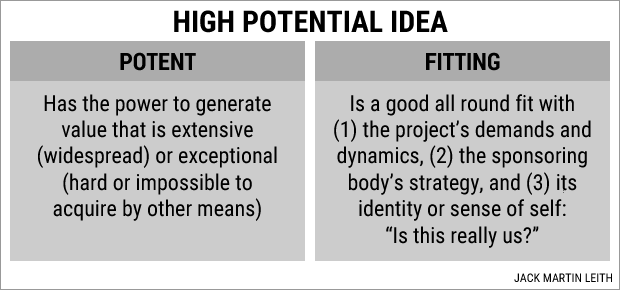
Now-to-New practitioners use mind, body and spirit to create some ‘thing’ that generates extensive or exceptional value, meaning and joy for customers or users and other beneficiaries.
The practitioners experience value, meaning and joy themselves in the course of their work, which motivates, rewards and fulfils them.
Continue reading
The evolution of the Now-to-New project model
How the term Now-to-New came into being
Now-to-New: how it began, what came next and current status
Readiness work sets the Now-to-New project in motion
The seven kinds of Now-to-New work
Some open source and proprietary Now-to-New methods
The three Now-to-New action modes — Part 1
Search the site
Not case sensitive. Do not to hit return.

